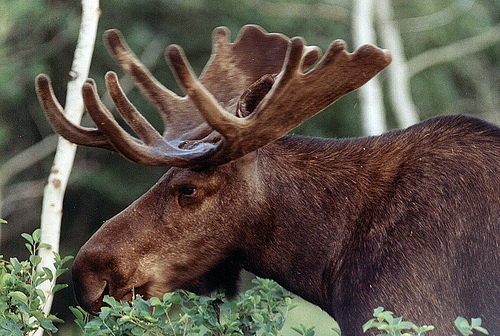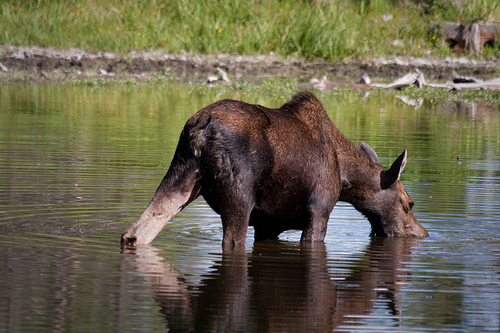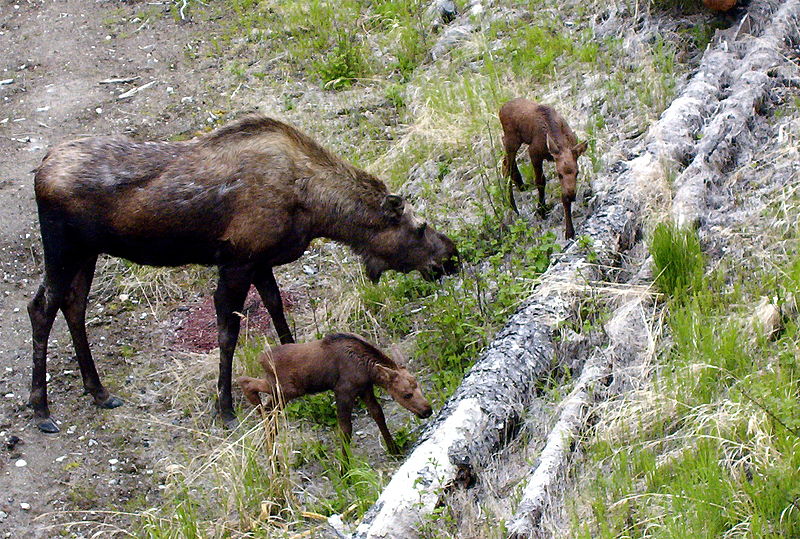
Nutrition
Adult Moose
 These huge mammals are herbivores, which mean they consume plants
for energy. They mainly eat willows (such as
Salix
alba),
trembling aspen (Populus
tremuloides),
redosier dogwood (Cornus stolonifera),
red maple (Acer rubrum),
striped maple (Acer pennsylvanicum),
white birch (Betula
papyrifera),
beaked hazelnut
(Corylus rostrata),
pin cherry (Prunus
pensylvanica) and, primarily in winter,
balsam fir
(Abies balsamea).
The aquatic plants that they particularly consume are
water shield (Brasenia
schreberi),
yellow pond lily (Nuphar sp.) and
pondweed
(Potamogeton
sp.), which constitutes a preferred and important part of the
moose's diet in summer (Mooseworld.com). The moose uses its modified
jaw to feed on fresh leaves and twigs. They can eat the plants via browsing or taking a twig into their
mouth and then pulling sideways to strip off a greater amount of
leaves. In order to do this motion, they need strong, thick lips and
tongue.
These huge mammals are herbivores, which mean they consume plants
for energy. They mainly eat willows (such as
Salix
alba),
trembling aspen (Populus
tremuloides),
redosier dogwood (Cornus stolonifera),
red maple (Acer rubrum),
striped maple (Acer pennsylvanicum),
white birch (Betula
papyrifera),
beaked hazelnut
(Corylus rostrata),
pin cherry (Prunus
pensylvanica) and, primarily in winter,
balsam fir
(Abies balsamea).
The aquatic plants that they particularly consume are
water shield (Brasenia
schreberi),
yellow pond lily (Nuphar sp.) and
pondweed
(Potamogeton
sp.), which constitutes a preferred and important part of the
moose's diet in summer (Mooseworld.com). The moose uses its modified
jaw to feed on fresh leaves and twigs. They can eat the plants via browsing or taking a twig into their
mouth and then pulling sideways to strip off a greater amount of
leaves. In order to do this motion, they need strong, thick lips and
tongue.
 When browsing leaves, the moose eats the vegetation that is
at the end of the branch, and then proceeds inwards toward the main
stem or trunk. Moose tend to stay where food is readily
available. Plants are really low in nutritional value which means
that the moose must eat a lot of vegetation to get its strength and
to grow in size. An average moose eats about 40-50 pounds of
vegetation a day!
When browsing leaves, the moose eats the vegetation that is
at the end of the branch, and then proceeds inwards toward the main
stem or trunk. Moose tend to stay where food is readily
available. Plants are really low in nutritional value which means
that the moose must eat a lot of vegetation to get its strength and
to grow in size. An average moose eats about 40-50 pounds of
vegetation a day!
Young Moose
 A young moose, also called calf, is also an herbivore. The main
source of nutrition for a calf is their mother’s milk. They receive
their mother’s milk from birth until they are weaned off of it at
the age of about five months. However, several weeks after being
born, the calf starts to browse on vegetation while still drinking
its mother’s milk. The mother shows the calf how to eat plants and
leaves so that the calf learns how to survive on its own.
A young moose, also called calf, is also an herbivore. The main
source of nutrition for a calf is their mother’s milk. They receive
their mother’s milk from birth until they are weaned off of it at
the age of about five months. However, several weeks after being
born, the calf starts to browse on vegetation while still drinking
its mother’s milk. The mother shows the calf how to eat plants and
leaves so that the calf learns how to survive on its own.
Click here if you are interested in seeing a moose eat aquatic
plants!
Click here if you are interested in seeing a moose eating
terrestrial plants!
Go to Reproduction to see how the moose reproduces!
Back to Homepage